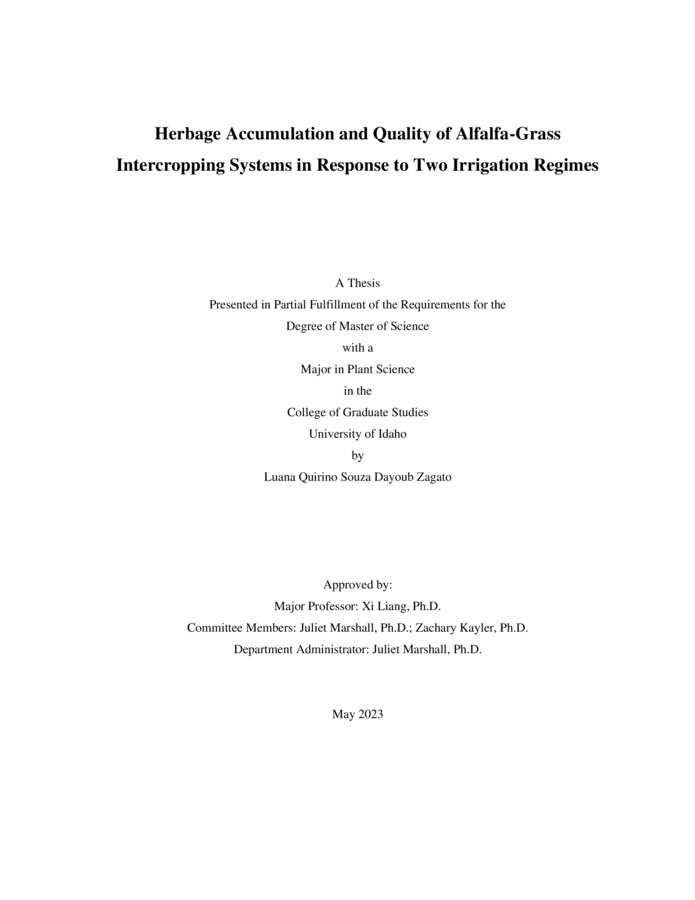Herbage Accumulation and Quality of Alfalfa-Grass Intercropping Systems in Response to Two Irrigation Regimes
Quirino Souza Dayoub Zagato, Luana. (2023-05). Herbage Accumulation and Quality of Alfalfa-Grass Intercropping Systems in Response to Two Irrigation Regimes. Theses and Dissertations Collection, University of Idaho Library Digital Collections. https://www.lib.uidaho.edu/digital/etd/items/quirinosouzadayoubzagato_idaho_0089n_12580.html
- Title:
- Herbage Accumulation and Quality of Alfalfa-Grass Intercropping Systems in Response to Two Irrigation Regimes
- Author:
- Quirino Souza Dayoub Zagato, Luana
- ORCID:
- 0009-0007-4775-4538
- Date:
- 2023-05
- Program:
- Plant Sciences
- Subject Category:
- Agronomy
- Abstract:
-
Alfalfa-hay is frequently produced for its excellent yield and quality. Due to the extended growing season, irrigation is the most challenging practice in alfalfa. Incorporating grasses into alfalfa cropping systems may shorten crop water use, refine water use efficiency, and increase fiber digestibility. This experiment compares the herbage accumulation and quality of hay for pure alfalfa to mixed and interrow cropping in response to full and deficit irrigation. A field experiment was set at the Aberdeen Research & Extension Center, University of Idaho, in 2020 and 2021. There were ten alfalfa-grass planting configurations: pure alfalfa, 75% alfalfa + 25% grass in mixture with three grass species (i.e., tall fescue, orchardgrass, and meadow bromegrass), 50% alfalfa + 50% grass in mixture with the three grass species, and 50% alfalfa + 50% grass in alternate rows with the three grass species. Results indicated that the herbage accumulation of the first year was greater than the second year; the first cuts yielded more than the other two cuts for both years; there were no differences between intercrops within cuts during 2021; concerning the irrigation regimes within cuts, the differences were observed during the third cut of 2020 and the second cut of 2021, being the herbage accumulation of the full irrigation regime greater than that of deficit irrigation. The differences between intercrops within cuts happened mainly in the first cut, especially for acid detergent fiber and total digestible nutrients; the highest crude protein content was observed in the third cut of the two years; in general, the neutral detergent fiber amount was greater for the intercrops in alternate rows. There was a negative correlation between crude protein and neutral detergent fiber; the same was observed for acid detergent fiber; however, the correlation with crude protein was positive for the total digestible nutrients. Therefore, both the irrigation regime and intercropping system significantly affect herbage accumulation and hay quality.
- Description:
- masters, M.S., Plant Sciences -- University of Idaho - College of Graduate Studies, 2023-05
- Major Professor:
- Liang, Xi
- Committee:
- Marshall, Juliet; Kayler, Zachary
- Defense Date:
- 2023-05
- Identifier:
- QuirinoSouzaDayoubZagato_idaho_0089N_12580
- Type:
- Text
- Format Original:
- Format:
- application/pdf
- Rights:
- In Copyright - Educational Use Permitted. For more information, please contact University of Idaho Library Special Collections and Archives Department at libspec@uidaho.edu.
- Standardized Rights:
- http://rightsstatements.org/vocab/InC-EDU/1.0/

